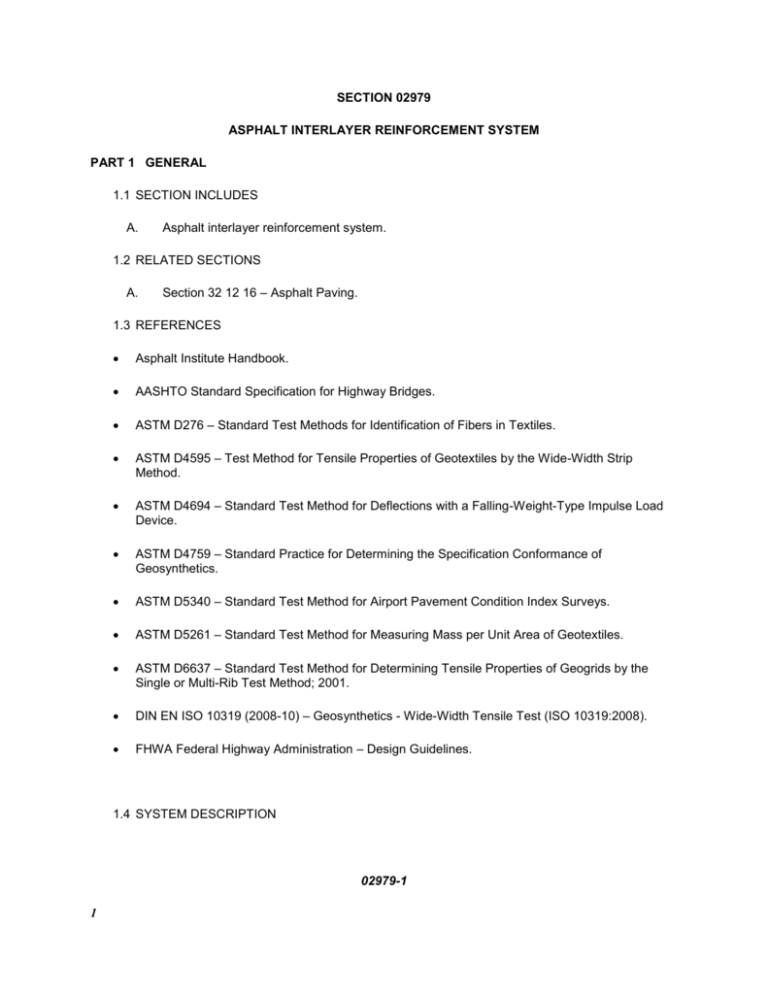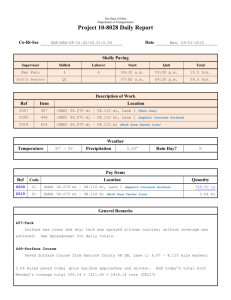GlasGrid TF System Specification
advertisement

SECTION 02979 ASPHALT INTERLAYER REINFORCEMENT SYSTEM PART 1 GENERAL 1.1 SECTION INCLUDES A. Asphalt interlayer reinforcement system. 1.2 RELATED SECTIONS A. Section 32 12 16 – Asphalt Paving. 1.3 REFERENCES Asphalt Institute Handbook. AASHTO Standard Specification for Highway Bridges. ASTM D276 – Standard Test Methods for Identification of Fibers in Textiles. ASTM D4595 – Test Method for Tensile Properties of Geotextiles by the Wide-Width Strip Method. ASTM D4694 – Standard Test Method for Deflections with a Falling-Weight-Type Impulse Load Device. ASTM D4759 – Standard Practice for Determining the Specification Conformance of Geosynthetics. ASTM D5340 – Standard Test Method for Airport Pavement Condition Index Surveys. ASTM D5261 – Standard Test Method for Measuring Mass per Unit Area of Geotextiles. ASTM D6637 – Standard Test Method for Determining Tensile Properties of Geogrids by the Single or Multi-Rib Test Method; 2001. DIN EN ISO 10319 (2008-10) – Geosynthetics - Wide-Width Tensile Test (ISO 10319:2008). FHWA Federal Highway Administration – Design Guidelines. 1.4 SYSTEM DESCRIPTION 02979-1 1 A. Flexible Pavements: Provide GlasGrid interlayer reinforcement system installed between asphalt layers in a pavement structure to distribute the load and reinforce the pavement and reduce reflective cracking distresses. B. Rigid or Composite Pavements: Provide GlasGrid interlayer reinforcement system installed between freshly leveled asphalt overlay to absorb the strain and stress energy developed by traffic-induced working concrete joints and by slab shrinkage and expansion due to thermal changes 1.5 DESIGN REQUIREMENTS A. Design GlasGrid interlayer system in accordance with the local codes and regulations and the design guidelines of Saint-Gobain ADFORS and the following: 1. Existing pavement should show no signs of poor drainage, pumping of fines, excessive deflections or structural instability. 2. Perform a field evaluation including a visual distress survey in accordance with a pavement condition index methodology, similar to ASTM D5340, and deflection testing such as falling weight deflectometer, similar to ASTM D4694, to determine the effective modulus of the existing pavement section. 3. Make all repairs as required prior to placement of interlayer system. 1.6 SUBMITTALS A. Submit under provisions of Section 01 30 00. B. Submittals of “Shop and Setting Drawings”, “Working Drawings”, “Catalogue Data” and “Certifications” for review shall be submitted in accordance with appropriate sections of the General Provisions. Submittals and Certifications required are as follows: C. D. 1. Catalog data and recent certification, performed at most 1 year prior to the submittal, showing that the asphalt reinforcement grid and tack coat meets the specified requirements. 2. No sample of the tack coat is required. 3. Manufacturer’s installation instructions and general recommendations. Product Data: Manufacturer’s data sheets on each product to be used, including: 1. Preparation instructions and recommendations. 2. Storage and handling requirements and recommendations. Samples: Enough material should be supplied to prepare two samples of each type of fiberglass grid and interlayer grid specified. Each sample shall be 305 mm by 203 mm (12” by 8”) and include a minimum of 5 ribs. 02979-2 1 E. Certification: Shall provide minimum average roll values, provide annual letter of compliance from accredited third party testing facility, and tests used to determine those properties. F. List of at least five comparable projects that are similar in terms of size and application, and where the results of using the specific asphalt reinforcement grid and tack combination can be verified after a minimum of three years of service life. G. Additional information as requested by the Engineer to fully evaluate the product. 1.7 QUALITY ASSURANCE A. B. C. Manufacturer Qualifications: 1. Manufacturer with at least 20 years of documented experience in the manufacture and installation of fiberglass interlayer grids to reduce thermal or load associated cracking distress, and in the manufacture of the tack coat that meets the specification. 2. Manufacturer with documented evidence of an established quality control program to assure products with consistent compliance with the requirements of this specification. Such a program would be ISO 9001:2008 Registration. 3. Annual conformance testing performed by an accredited third party testing facility. Installer Qualifications: 1. Firm with documented experience in the installation of fiberglass interlayer grid systems with at least two projects of similar construction and scope. 2. Include brief description of each project by name, and phone number of owner’s representative knowledgeable in each listed project. Pre-Construction Meeting: 1. Prior to construction of interlayer reinforcement system, conduct a meeting at the site with the materials supplier, the installer, and the Contractor to review the preparation and installation requirements. 2. Notify the Owner and the Engineer at least 3 days in advance of the time of the meeting. 1.8 DELIVERY, STORAGE, AND HANDLING 1 A. Store products in manufacturer’s unopened packaging until ready for installation. B. Store in a dry, covered location that is free of dust, dirt, and moisture. Prevent excessive mud, fluid concrete, asphalt, or other deleterious materials from coming in contact with reinforcement grid materials. C. Store at temperatures above minus 29°C (minus 20°F) and 75°C (167°F) and maximum relative humidity of 85%. 02979-3 1.9 PROJECT CONDITIONS A. Do not place grid reinforcement when the asphalt surface is wet, or contaminated with oil, soil or excessive dust. B. Do not place asphalt during wet or freezing weather that prevents conformance with specified requirements. C. Do not install asphalt on the grid reinforcement when the underlying asphalt surface is cooler than 10°C (50°F), warmer than 60°C (140°F), or in the case of new asphalt, prior to the asphalt cooling to 43°C (110°F) at least once previously. PART 2 PRODUCTS 2.1 MANUFACTURERS A. Acceptable Manufacturer: Saint-Gobain ADFORS, 1795 Baseline Rd., Grand Island, NY 14072-2010 USA, Phone: 800-866-9445 or 716-775-3900, and their authorized distributors. B. Substitutions submitted no later than 16 days prior to bid will be considered in accordance with provisions of Section 01 60 00. 2.2 MATERIALS A. The asphalt reinforcement grid shall consist of a high strength, fiberglass grid custom knitted and coated with a patent-pending elastomeric polymer and self-adhesive glue. The grid is combined with a patent-pending multilayer tack film designed to enhance the bond between layers of hot mix asphalt and replace conventional tack coats. In addition, the reinforcement grid shall have the following/adhere to the following Minimum Average Roll Values (MARV) for material properties and should adhere to the strength properties in Table 1 and the performance requirements of Table 2. 02979-4 1 Table 1 Material and Strength Properties PRODUCT PROPERTIES METHOD Strength Properties Material Properties Aperture Size (Center to Center) Type 1 Type 2 12.5 x 12.5 (0.5 x 0.5) 25 x 25 (1.0 x 1.0) Greater than or equal to 50 Elastomeric Polymer Greater than or equal to 50 Elastomeric Polymer % >25 >25 g/m² (oz/yd²) 432 (12.7) 432 (12.7) m (ft.) 1.5 (5.0) 1.5 (5.0) ASTM D36 °C (°F) Greater than 149 (300) Greater than 149 (300) Tensile Strength (MD x CD) ASTM D6637 kN/m (lb./in) 100 x 100 (560 x 560) 100 x 100 (560 x 560) Tensile Strength @2% ASTM D6637 kN/m (lb./in) 80 x 80 (456 x 456) 80 x 80 (456 x 456) Percent Open Area mm (inch) CW-02215 MOD.1 % Fiberglass Coating Tack Coat % Polymer Modified Mass / Unit Area ASTM D5261 Roll Width Fiberglas Coating Softening Point Elongation at Less than ASTM D6637 (%) Break 3 1 - Army Corp of Engineers test method correlated to light emitted through fabric. 02979-5 1 UNITS Less than 3 Table 2 Product Performance Requirements Performance Requirements TEST DESCRIPTION Temperature Comparison Job Mix Formula Compaction Temperature Requirement Field Millability and Recyclability Validation Field Milling of Asphalt with GlasGrid References or Reports Asphalt : Grid composite stiffness for durability of composite layers over life of pavement during individual and long term deformation 3Pt Beam Test at 70°F, Grid with polymer tack at mid depth relative to a control with polymer emulsion tack coat – cyclic stress controlled Haversquare loading Minimum Improvement Factor vs. Control Full Scale Plate Load Testing : Fatigue and Reflective Cracking Testing Plate Load Testing vs. Control Pavement Composite Modulus APT – Accelerated Pavement Testing PERFORMANCE Coating Softening Point > HMA Compaction Temperature Documented Experience ≥ 5x MMLS3 Scaled APT 1 Testing vs. Control 02979-6 1 METHOD OF MEASURE Coating Softening Temperature vs. HMA Asphalt Binder Compaction Temperature Fatigue and Reflective Cracking 1 TEST METHOD ≥ 3x ≥ 1.5x Note to specifier – Delete Text box prior to placement in the project specification Grid aperture size selection: Type 1 Grid, is to be used for asphalt mixes with a maximum particle size, less than 12.5 mm (1/2”) Type 2 Grid, is to be used for asphalt mixes with a maximum particle size, equal to or greater than 12.5 mm (1/2”) The grid size may also be selected based on local environmental conditions, mix stability, past performance or user preference. 02979-7 1 PART 3 EXECUTION 3.1 PREPARATION A. Do not begin GlasGrid interlayer system until existing pavement condition has been evaluated and all repairs have been completed. B. Seal cracks between 3mm (1/8”) and 6 mm (1/4”) with an acceptable crack filler. Repair wider cracks using a method that provides a level surface. All holes shall be filled with hot asphalt and compacted level with adjacent surfaces. C. Surfaces shall be mechanically cleaned by sweeping and vacuuming and be free of oil, vegetation, sand, dirt, water, gravel, and other contaminants prior to placement of interlayer reinforcing. D. If subgrade preparation is the responsibility of others, notify Engineer of unsatisfactory preparation. Do not begin work until unsatisfactory conditions have been rectified. E. Cracks shall be marked and recorded prior to and after the true and leveling course. Identifying and preserving the crack location will ensure that the grid is properly centered on each crack when full grid coverage of the site is not specified. 3.2 INSTALLATION A. Storage of Material: 1. Prior to use, store reinforcement grid rolls in unopened packaging vertically (on end) under dry, covered conditions free from dust, dirt, and moisture to prevent roll distortion and contamination. 2. Store the product at temperatures above minus 29°C (-20°F) with a relative humidity of less than 85%. B. Install GlasGrid interlayer reinforcement system in accordance with Tensar International’s installation guidelines. C. Leveling Course: D. 1. Leveling course shall be a minimum thickness of 19 mm (3/4”) and shall have a surface temperature warmer than 10°C (50°F), cooler than 60° C (140° F) and will have cooled to 43°C (110°F) at least once previously. 2. Crack areas showing excessive surface irregularities shall be leveled prior to placement. 3. Slab joint showing upward tenting shall be saw-cut to relieve pressure prior to leveling. Asphalt Reinforcement Grid Placement: 02979-8 1 E. 1. Surface temperature shall be between10°C (50°F) and 60°C (140°F) prior to placing the grid reinforcement. 2. The placement surface must be dry. Since moisture affects the adhesion of the grid to the pavement surface, grid placement should not be undertaken if rain is likely to fall prior to covering the grid with an asphalt mat overlay. Grid that is placed and will not adhere due to moisture shall be removed and replaced at the Contractor’s expense. 3. Reinforcement grid shall be laid out by mechanical means or by hand using sufficient pressure to eliminate ripples. Remove any ripples by pulling the grid tight. Cutting of the grid may be done on tight radii to prevent ripples. 4. Lap transverse joints in the direction of the paving 76 mm to 152 mm (3-6”); longitudinal joints shall be overlapped 25 mm to 50 mm (1-2”) or as recommended by the manufacturer, whichever is greater. 5. After placement, activate self-adhesive glue by rolling with a rubber coated drum roller or a pneumatic tire roller until proper adherence occurs. In no instance shall steelwheeled or vibratory rollers be used. Rolling shall continue until the adhesive is activated and the grid is bonded to the truing and leveling course. Generally, this can be accomplished in one or two roller passes. During rolling operations, roller tires shall be kept clean to the satisfaction of the Engineer. Reinforcement shall be laid and rolled over ironworks (i.e., manhole covers, drainage grates, etc.). Once the grid has been rolled, these portions of the mats covering the ironworks shall be removed by cutting the reinforcement grid with a utility knife or other similar tool. 6. Construction and emergency vehicles will be allowed to run on the reinforcement grid after rolling. However, any damaged or de-bonded sections of the grid resulting from these vehicles, as determined by the Engineer, shall be immediately replaced with new grid sections, taking care to place the adhesive backing down and to overlap the grid already in place. As before, replacement sections shall be rolled in accordance with manufacturer’s recommendations. Grid shall be rolled until the adhesive is activated and the replacement grid section is bonded to the truing and leveling course. Any dirt, dust or other contaminants deposited on the grid-covered truing and leveling course by the construction equipment, maintenance vehicles, or emergency vehicles shall be removed by mechanical sweeping or vacuuming the surface. No additional payment will be made to replace sections of grids damaged by construction equipment, maintenance vehicles, or emergency traffic. No payment will be made to sweep or vacuum the surface, or to remove contaminates deposited by such traffic. 7. Protect the asphalt reinforcing grid until placement of the finished asphalt topping. Repair damaged sections prior to placement of finished asphalt topping. Asphalt Placement 1. Place the asphalt overlay course in accordance with Section 32 12 00. Place the asphaltic overlay course the same day the interlayer reinforcing grid is placed. a. Overlay course shall be a minimum compacted thickness of 40 mm (1-1/2”) b. In order to activate the tack film, 02979-9 1 1) 2. F. The surface temperature must be 21°C (70°F) and the asphalt mix being placed over the interlayer material must be placed at a minimum temperature of 140°C (285°F). When a tack coat is specified, the approved tack coat should be used beneath the geogrid interlayer system. TACK COAT APPLICATION (if required due to heavily oxidized leveling course) 1. Application of tack may be carried out prior to the placement of the interlayer at the discretion of the Engineer and the Contractor. Logistics site conditions and / or environmental parameters may influence the decision. Discussions with the manufacturer may provide additional insight into this decision. 2. The asphalt reinforcing grid has a self-adhesive backing, so the tack coat is not required for the installation. However, if a tack is specified for other reasons, such as the surface is oxidized, the tack must (in the case of an emulsion tack) be allowed to break and cure before the GlasGrid TF is placed. Breaking is defined as the point at which the brown-colored tack turns black. Curing occurs when the residual asphalt cement contains no solvents (water or any volatiles). After the GlasGrid TF has been installed on the broken and cured tack coat, the adhesion test should be done prior to placing any asphalt and prior to asphalt trucks running on the GlasGrid TF on tacked surface. Note to specifier: When tack coats are specified, the following products are recommended by the manufacturer: Type 1 – NTSS -1HM, anionic trackless tack. Type 2 – Cationic, rapid set, CRS-2P. Type 3 – Paving Grade AC, PG64–XX. Hot spray AC tacks work well in cooler weather, when surface temperatures are at or below 15°C (60°F). When surface temperatures exceed 20°C (68°F), the manufacturer recommends either raising the grade of the PG Tack coa,t or that an emulsion be applied in place of the hot spray AC. A. Do not dilute emulsified asphalts at the terminal or in the field. B. Provide a certificate of compliance with the product specifications immediately prior to use. C. Prepare surfaces as specified prior to application. D. Unless otherwise recommended by the manufacturer, apply tack coat at the residual rate of 0.02 to 0.05 gallons per square yard of surface area. The rate should be specified by the Engineer, but could vary depending on the installation or surface conditions. E. Protect adjacent surfaces and prevent spattering of tack coat when placed adjacent to curbs, gutter, structures, and other adjacent surfaces. Clean any surfaces where they have been contaminated by the tack coat. 02979-10 1 3.3 FIELD QUALITY CONTROL A. Testing and Inspection will be provided by the Owners Testing Agency as specified in Section 01 40 00 Testing and Inspection Services. Notify the Engineer 72 hours in advance of testing. B. Testing and Inspection shall be provided by an independent laboratory provided by the Contractor and acceptable to the Engineer. C. Perform adhesion tests in accordance with the following: D. 1. Place a 1 m² (1 sq. yd.) of interlayer reinforcing grid on a properly prepared leveling course. 2. Activate self-adhesive glue by rolling with a rubber-tired roller or by applying adequate pressure to fully activate the pressure-sensitive adhesive. 3. Use a calibrated spring balance by inserting the hook of the balance under the center of the grid and pulling upward until the grid starts to pull away from the surface. 4. A 9 kg (20 pound) pull is required without pulling the grid free or creating ripples in the grid. 5. Consult grid manufacturer if grid does not meet this pull rating and do not place asphalt topping until an acceptable adhesion is achieved. Frequency of Tests: 1. Adhesion Test: Provide a minimum of one test per 300 m² (3,000 sq. ft.) of surface area. 3.4 MANUFACTURER’S FIELD SERVICES A. A manufacturer’s representative shall be present on site for the initial start of the installation of the interlayer reinforcing grid 3.5 PROTECTION A. Protect installed product until completion of project. B. Repair or replace damaged products before Substantial Completion. END OF SECTION 02979-11 1








